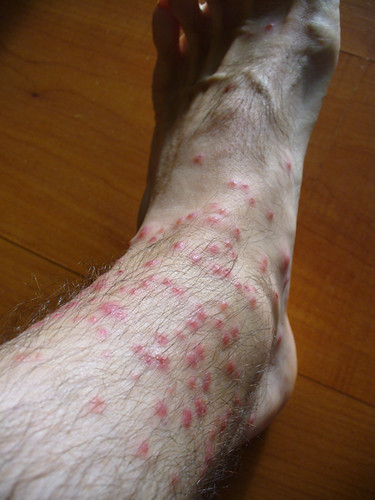10 best and cheapest ways to avoid chiggers in South America.
What are chiggers anyway?
 You don’t see chiggers. They can be a serious nuisance, because the itch is diabolic. I have seen severe infections after scratching chigger bites. For some people the itch goes on for a week!
You don’t see chiggers. They can be a serious nuisance, because the itch is diabolic. I have seen severe infections after scratching chigger bites. For some people the itch goes on for a week!
So what are they? Actually, they are more than one sort – and that is the reason why there are so many conceptions and misconceptions about chiggers. Chiggers are normally referring to the larval stage of microscopic Trombiculidae mites (thus a small arachnid) and they bite but do not dig under the skin. However, a similarly named evil – the Chigoe flea a.k.a. as jigger – Tunga penetrans is common in South America causes similar symptoms – and in this case the little flea does bury underneath the skin to eventually produce eggs and detach. Since protection against both no-see-ums is similar….let us just concentrate on that.
How to protect yourself against chiggers
While some people would buy expensive protection with Permethrin soaked garments and others will get sulphur powder to dust their entire footwear, socks and pant-legs (it comes with a distinct rotten egg odor- and will not be popular among your fellow travellers using my technique!), here is the less high tech, less messy, cheap and fool proof way to protect you against chiggers
- Rubber boots – Wellies. There is no better protection against the crawlies on the ground than rubber boots. Not only does chiggers have a hard time climbing the rubber shafts, but that also goes for army ants. Imagine standing in an army ant swarm without having to hop up and down while you are surrounded by the ants. Standing still there is actually a chance you may see those illusive ant following antbirds such as the Hairy-crested, White-masked and White-plumed Antbirds. But the thought of having to walk around in uncomfortable high rubber boots in warm climate is the one thing that usually put people off from my first advice. Fortunately, there are a few things you can do to increase comfort. The first trick is to get inexpensive very soft rubber boots. These sell cheaply in Peru (around 15 US$) up to size 10 or 10.5 (up to size 44 European) but larger sizes are impossible to get. They don’t weigh much either and are easy to pack as the fold up.
The fit of these cheap boots are usually quite poor, but by inserting the insoles of your sneakers you get perfect fit. Use double thin socks to lead off moisture, pre-treat your feet with anti-transpiring and powder the inside of your boots with foot powder. Whenever you are in the car or in the canoe, change to sneakers or sandals, by having these handy. - Tuck in pants. The rubber boots will not be of much use if your pantlegs hang outside of your boots.
- Spray DEET (OFF is commonly available in Peru) on socks and boot lining. If an occasional chigger would venture above your boot shaft, this should prevent it from climbing down your boots.
- Spray DEET around the waist on top of the clothing and also on the bare skin at the lining of the pants. If the chiggers don’t enter to your skin from your feet, you may still get them around the waist if you brush against any branches or enter the forest.
- Coming back to the lodge, take a shower straight away and scrub legs and any part where the clothing has been tight i.e. private parts. Have a set of clothing reserved for after showers which you wear for your lunch and dinner. This set of clothing shall not be taken into the forest at any time.
- If you been in high grass or entered the dense forest off the trail (birders do that you know), you need to change clothing the next day or spray the cloths with deet in the evening. If your clothes have been washed make sure they are hung on lines with cloth-hangers. Why? Pîcture this: When your clothes finally have dried, some strong wind blows them off the line into the grass lawn totally infested with chiggers.
- Change socks and underwear every day. (Get these garment infested with chiggers and you will know about it.)
- Don’t ever walk over the clearing in sneakers or sandals – especially not if you wear socks. Without socks, don’t forget to wash of the feet and the sandals afterwards. The clearing grass is the worst for chiggers. Even worse than the forest.
- Don’t sit down or lie down on the leaf litter in the forest. Some early neo-tropical birders claim that the best way to look at canopy birds in with lying down on the trail. That may be, but it does involve some serious consequence.
- The same goes for your back pack – don’t put the back pack on the leaf litter….Think for yourself cause and effect when you try scratching your itching back at night?
Finally, two more links for more information.
- Wiki. About the harvest mites in general and chiggers in particular
- From Nina Bicknese, Missouri department of conservation
As from this moment, Kolibri Expeditions will provide to our clients free OFF in spray cans and rubber boots to size 43 European. If you need larger size, please consider bringing a pair from home to donate to us for the benefit of future travellers. Say no to scratching now.
Foto by Scott Zona by Creative common License on Flickr.
